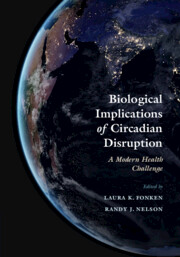Book contents
- Biological Implications of Circadian Disruption
- Biological Implications of Circadian Disruption
- Copyright page
- Contents
- Contributors
- Preface
- 1 Introduction to Circadian Rhythms
- 2 Central Clock Dynamics
- 3 Melatonin, Light, and the Circadian System
- 4 Disrupted Circadian Rhythms, Stress, and Allostatic Load
- 5 Disrupted Circadian Rhythms and Mental Health
- 6 Circadian Rhythms and Cognitive Functioning
- 7 Circadian Rhythm Disruption in Aging and Alzheimer’s Disease
- 8 Circadian Rhythms Regulate Neuroinflammation after Traumatic Brain Injury and Spinal Cord Injury
- 9 Disrupted Circadian Rhythms and Neuroendocrine Function in Fertility
- 10 Disrupted Circadian Rhythms and Metabolic Function
- 11 Disrupted Circadian Rhythms, Time Restricted Feeding, and Blood Pressure Regulation
- 12 Disrupted Circadian Rhythms and Immune Function
- 13 Circadian Rhythms and Cardiac Function
- 14 Disrupted Circadian Rhythms and Cancer
- 15 Light Effects across Species in Nature
- 16 Measurement and Analysis of Exposure to Light at Night in Epidemiology
- Index
- References
16 - Measurement and Analysis of Exposure to Light at Night in Epidemiology
Published online by Cambridge University Press: 07 October 2023
- Biological Implications of Circadian Disruption
- Biological Implications of Circadian Disruption
- Copyright page
- Contents
- Contributors
- Preface
- 1 Introduction to Circadian Rhythms
- 2 Central Clock Dynamics
- 3 Melatonin, Light, and the Circadian System
- 4 Disrupted Circadian Rhythms, Stress, and Allostatic Load
- 5 Disrupted Circadian Rhythms and Mental Health
- 6 Circadian Rhythms and Cognitive Functioning
- 7 Circadian Rhythm Disruption in Aging and Alzheimer’s Disease
- 8 Circadian Rhythms Regulate Neuroinflammation after Traumatic Brain Injury and Spinal Cord Injury
- 9 Disrupted Circadian Rhythms and Neuroendocrine Function in Fertility
- 10 Disrupted Circadian Rhythms and Metabolic Function
- 11 Disrupted Circadian Rhythms, Time Restricted Feeding, and Blood Pressure Regulation
- 12 Disrupted Circadian Rhythms and Immune Function
- 13 Circadian Rhythms and Cardiac Function
- 14 Disrupted Circadian Rhythms and Cancer
- 15 Light Effects across Species in Nature
- 16 Measurement and Analysis of Exposure to Light at Night in Epidemiology
- Index
- References
Summary
Artificial light at night (ALAN) has become an increasingly important topic in epidemiology, as numerous studies have established a relationship between ALAN and adverse health effects, including cancer, obesity, depression, and sleep disruption. ALAN exposure measurements, however, vary from study to study and each measurement method has strengths and weaknesses. We review and summarize the pros and cons of different methods that have been used to quantify the light exposure in epidemiological settings, which include widely used remote sensing data, interview data, and individual-level wearable and handheld equipment. We also summarize the methodological approaches that have been used to analyze the spatial distribution of ALAN, as well as the relationships between ALAN and various adverse health outcomes. Finally, we highlight emerging technologies that could be used to measure the ALAN exposure for epidemiological studies, and how spatial analytical methods, such as geographically weighted regression and spatial autoregressive models can be leveraged to understand the spatial and temporal characteristics of ALAN and its mechanisms in regulating human physiology and behavior.
- Type
- Chapter
- Information
- Biological Implications of Circadian DisruptionA Modern Health Challenge, pp. 356 - 380Publisher: Cambridge University PressPrint publication year: 2023

